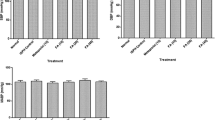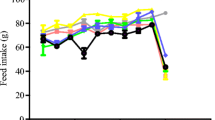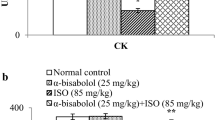Abstract
This study was undertaken to evaluate the preventive role of S-allyl cysteine sulphoxide (SACS) in isoproterenol (ISO)-induced cardiotoxicity in male Wistar rats. Myocardial infarction was induced by subcutaneous injection of ISO (150 mg/kg) once a day for 2 days. SACS (40 and 80 mg/kg) was given as pretreatment orally daily for a period of 35 days using an intragastric tube. SACS pretreatment significantly lowered thiobarbituric acid reactive substances (TBARS) and increased the activities of mitochondrial superoxide dismutase (SOD), catalase, glutathione peroxidase (GPx), glutathione S-transferase (GST), and the concentration of reduced glutathione (GSH) in myocardial infarcted rats. SACS pretreatment also increased significantly the levels of mitochondrial phospholipids and decreased the levels of mitochondrial cholesterol, free fatty acids (FFAs), triglycerides (TGs) and calcium, and the activity of xanthine oxidase (XOD) in heart. Further, the activities of isocitrate dehydrogenase (ICDH), succinate dehydrogenase (SDH), α-ketoglutarate dehydrogenase (α-KGDH), NADH-dehydrogenase, and cytochrome C-oxidase were significantly elevated in the mitochondrial fraction of the heart in the SACS-pretreated ISO-induced rats. Oral administration of SACS for a period of 35 days to the normal control rats did not show any significant effect. Histopathological studies of the myocardial tissue showed a protective role of SACS in the myocardial-infarcted rats. The effect at a dose of SACS 80 mg/kg was more effective than the dose 40 mg/kg. The results of the study conclude that SACS protect the mitochondria of the ISO-induced myocardial-infarcted rats.



Similar content being viewed by others
References
Saraste A, Pulkki K, Kallajoki M, Henriksen K, Parvinen M, Voipio-pulkki L (1997) Apoptosis in human acute myocardial infarction. Circulation 95:320–323
Marin GJ, Goldnethal MJ (2002) Understanding the impact of mitochondrial defects in cardiovascular disease: a review. J Card Fail 8:347–361. doi:10.1054/jcaf.2002.127774
Burton KP, McCord JM, Ghai G (1984) Myocardial alterations due to free radical generation. Am J Physiol Heart Circ Physiol 246:776–783
Kalyanaraman B, Konorev EA, Joseph J, Baker JE (1994) Radical generation and detection in myocardial injury. In: Rice-Evans CA, Burdon RH (eds) Free radical damage and its control. Elsevier Science, Amsterdam, pp 333–355
Richter C, Par JW, Ames B (1998) Normal oxidative damage to mitochondrial and nuclear DNA is extensive. Proc Natl Acad Sci USA 85:6465–6467. doi:10.1073/pnas.85.17.6465
Hornstra G, Barth CA, Galli C (1998) Functional food science and cardiovascular system. Br J Nutr 80:S113–S146. doi:10.1079/BJN19980107
Zhang XH, Lowe D, Gilies P, Fell S, Connecl MJ, Maslin DJ (2001) Gender may affect the action of garlic oil on plasma cholesterol and glucose levels of normal subjects. J Nutr 131:1471–1478
Ou CC, Tsao SM, Lin MC, Yin MC (2003) Protective action on human LDL against oxidation and glycation by four organosulfur compounds derived from garlic. Lipids 38:219–224. doi:10.1007/s11745-003-1054-4
Rahman K (2003) Garlic and aging: new insights into an old remedy. Ageing Res Rev 2:39–56. doi:10.1016/S1568-1637(02)00049-1
Nakamura H, Ishikawa M (1971) Effect of S-allyl cysteine sulphoxide on cholesterol metabolism. Kanzo 12:673–675
Sheela CG, Augusti KT (1992) Effect of S-allyl cysteine sulphoxide isolated from Allium sativum Linn and gugulipid in some enzymes and fecal excretion of bile acids and sterols in cholesterol fed rats. Indian J Exp Biol 33:337–341
Sheela CG, Agusti KT (1995) Antiperoxide effects of S-allyl cysteine sulphoxide isolated from Allium sativum Linn and gugulipid in cholesterol fed rats. Indian J Exp Biol 33:337–341
Le Bon AM, Vernevaut MF, Gunent L, Kahane R, Arnault I, Auger J, Haffner T, Siess MH (2003) Effects of garlic powders with varying alliin contents on hepatic drug metabolizing enzymes in rats. J Agric Food Chem 51:7617–7623. doi:10.1021/jf0346758
Sangeetha T, Darlin Quine S (2006) Preventive effect of S-allyl cysteine sulfoxide (alliin) on cardiac marker enzymes and lipids in isoproterenol induced myocardial injury. J Pharm Pharmacol 58:617–623. doi:10.1211/jpp.58.5.0006
Sangeetha T, Darlin Quine S (2006) Antilipoperoxidative and antioxidant effects of S-allyl cysteine sulfoxide on isoproterenol induced myocardial infarction in Wistar rats. J Biochem Mol Toxicol 20:167–173. doi:10.1002/jbt.20132
Sangeetha T, Darlin Quine S (2006) Preventive effect of S-allyl cysteine sulfoxide (alliin) on lysosomal hydrolases and membrane bound ATPases in isoproterenol-induced myocardial infarction in Wistar rats. J Biochem Mol Toxicol 21:118–124. doi:10.1002/jbt.20166
Johnson D, Lardy H (1967) Methods in enzymology. In: Estabrook RW (ed) Isolation of liver or kidney mitochondria. Academic Press, London, pp 94–96
Fraga CG, Leibovitz BF, Toppell AL (1988) Lipid peroxidation measured as thiobarbituric acid-reactive substances in tissue slices: characterization and comparison with homogenates and microsomes. Free Radic Biol Med 4:155–161. doi:10.1016/0891-5849(88)90023-8
Kakkar P, Das B, Viswanathan PN (1984) A modified spectrophotometric assay of superoxide dismutase. Indian J Biochem Biophys 21:130–132
Sinha AK (1972) Colorimetric assay of catalase. Anal Biochem 47:389–394. doi:10.1016/0003-2697(72)90132-7
Rotruck JT, Pope AL, Ganther HE, Swason AB, Hafeman DG, Hoekstra WG (1973) Selenium: biochemical role as a component of glutathione peroxidase. Science 179:588–590. doi:10.1126/science.179.4073.588
Habig WH, Pabst MJ, Jakoby WB (1974) Glutathione-S-transferase. The first enzymatic step in mercapturic acid formation. J Biol Chem 249:7130–7139
Ellman GL (1959) Tissue sulfhydryl groups. Arch Biochem Biophys 82:70–77. doi:10.1016/0003-9861(59)90090-6
Folch J, Lees M, Sloane Stanley GH (1957) A simple method for the isolation and purification of total lipids from animal tissues. J Biol Chem 226:497–509
Zilversmit BB, Davis AK (1950) Microdetermination of plasma phospholipids by TCA precipitation. J Lab Clin Med 35:155–161
Falholt K, Lund B, Falholt W (1973) An easy colorimetric micromethod for routine determination of free fatty acids in plasma. Clin Chim Acta 46:105–111. doi:10.1016/0009-8981(73)90016-8
Zlatkis A, Zak B, Boyle GJ (1953) A Simple method for determination of serum cholesterol. J Clin Med 41:486–492
Bergmeyer HU, Gawehn K, Grassl M (1974) Xanthine oxidase. In: Bergmeyer HU (ed) Methods of enzymatic analysis. Academic Press, New York, pp 521–522
King J (1965) Isocitrate dehydrogenase. In: Van D (ed) Practical clinical enzymology. Nostrand Co., London, p 363
Slater EC, Bonner WD (1952) The effect of fluoride on succinate oxidase system. Biochem J 52:185–196
Mehler AH, Kornberg A, Grisolia S, Ochoa S (1948) The enzymatic mechanism of oxidation-reductions between malate or isocitrate and pyruvate. J Biol Chem 174:961–977
Reed LJ, Mukherjee RB (1969) α-Ketoglutarate dehydrogenase complex from Escherichia coli. In: Lowenstein MJ (ed) Methods in enzymology. Academic Press, London, pp 53–61
Minakami S, Ringler RL, Singer TP (1962) Studies on the respiratory chain linked dihydrodiphosphopyridine nucleotide dehydrogenase-1. Assay of the enzyme in particulate and in soluble preparations. J Biol Chem 237:569–576
Pearl W, Cascarano J, Zweifach BW (1963) Microdetermination of cytochrome oxidase in rat tissues by oxidation on N-phenyl-p-phenylenediamine or ascorbic acid. J Histochem Cytochem 11:102–104
Lowry OH, Rosebrough NJ, Farr AL, Randall RJ (1951) Protein measurement with Folin phenol reagent. J Biol Chem 193:265–275
Korkina LG, Afanas’ev IB (1997) Antioxidant and chelating properties of flavonoids. Adv Pharmacol 38:151–163. doi:10.1016/S1054-3589(08)60983-7
Raghavendran HRB, Sathivel A, Devaki T (2005) Antioxidant effect of Sargasum polycystum against acetaminophen induced changes in hepatic mitochondrial enzymes during toxic hepatitis. Chemosphere 61:276–281. doi:10.1016/j.chemosphere.2005.01.049
Sathish V, Vimal V, Ebenezar KK, Devaki T (2002) Synergistic effect of nicorandil and amlodipine on mitochondrial function during isoproterenol induced myocardial infarction in rats. J Pharm Pharmacol 54:133–137. doi:10.1211/0022357021771841
Sathish V, Ebenezar KK, Devaki T (2003) Biochemical changes on the cardioprotective effect of nicorandil and amlodipine during experimental myocardial infarction in rats. Pharmacol Res 48:565–570. doi:10.1016/S1043-6618(03)00223-8
Chenko DI, Sopka NV, Kalinkin MN, Khanina NIA, Chelnokov VS (1990) The metabolic changes in myocardial subcellular fractions in the pathogenesis of ischemic heart disease. Patol Fiziol Eksp Ter 2:16–20
Starkov AA, Polster BM, Fiskum G (2002) Regulation of hydrogen peroxide production by brain mitochondria by Calcium and Bax. J Neurochem 83:220–228. doi:10.1046/j.1471-4159.2002.01153.x
Prasad K, Kalra J, Bharadwaj L (1993) Cardiac depressant effects of oxygen free radicals. Angiology 44:257–270. doi:10.1177/000331979304400401
Thirunavukkarasu C, Vijeya Singh JP, Selvendiran K, Sakthisekaran D (2001) Chemopreventive efficacy of selenium against N-nitrosodiethylamine-induced hepatoma in albino rats. Cell Biochem Funct 19:265–271. doi:10.1002/cbf.924
Vijayapadma V, Shaymaladevi CS (2001) Effect of fish oil on mitochondrial respiration in isoproterenol induced myocardial infarction in rats. Indian J Exp Biol 40:268–272
Guo Z, Muller D, Pentz R, Kress G, Siegers CP (1990) Bioavailability of sulphur containing ingredients of garlic in the rat. Planta Med 56:692. doi:10.1055/s-2006-961372
Acknowledgments
We gratefully thank Dr. Yukihiro Kodera, Wakunaga Pharmaceutical Co., Ltd., Hiroshima, Japan, for the generous gift of S-allyl cysteine sulphoxide (Alliin). For histopathological studies, the assistance of Prof. P. Viswanathan, Department of Pathology, Rajah Muthiah Medical College and Hospital, Annamalai University is gratefully acknowledged.
Author information
Authors and Affiliations
Corresponding author
Rights and permissions
About this article
Cite this article
Sangeetha, T., Darlin Quine, S. Preventive effect of S-allyl cysteine sulphoxide (Alliin) on mitochondrial dysfunction in normal and isoproterenol induced cardiotoxicity in male Wistar rats: a histopathological study. Mol Cell Biochem 328, 1–8 (2009). https://doi.org/10.1007/s11010-009-0066-9
Received:
Accepted:
Published:
Issue Date:
DOI: https://doi.org/10.1007/s11010-009-0066-9




